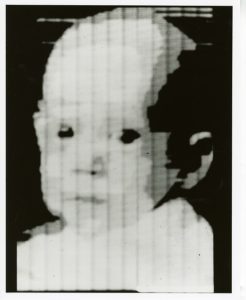I owe Russel Kirsch a lot, not least the CAT scans that helped me survive cancer twice, and this week monitored another health concern.

Russell Kirsch / NIST
Then, of course, there’s digital photography, which I embraced four decades after Kirsch’s first experiments with digital imaging — during my first cancer “comeback.”
As Kirsch explains in the video above, his infant son, Walden, was the subject of the world’s first digital photograph, scanned on SEAC, the first programmable American computer, a giant machine built in 1950.
How many of us alive then, if we’d even heard about it, had any inkling that this small, 176 x 176-pixel, 2 x 2 inch image would lead to the day when almost everyone carries a miniature digital camera in their pocket?
I hadn’t yet received the camera designed to “put a camera in everyone’s hands,” the Kodak Brownie.
Not satisfied with his original breakthrough, after retirement Kirsch went on to improve the pixel process by developing the method that smoothed the kind of pixellation photographers dread, giving us the incredible high-resolution images we enjoy today.
Thank you Mr. Kirsch!














